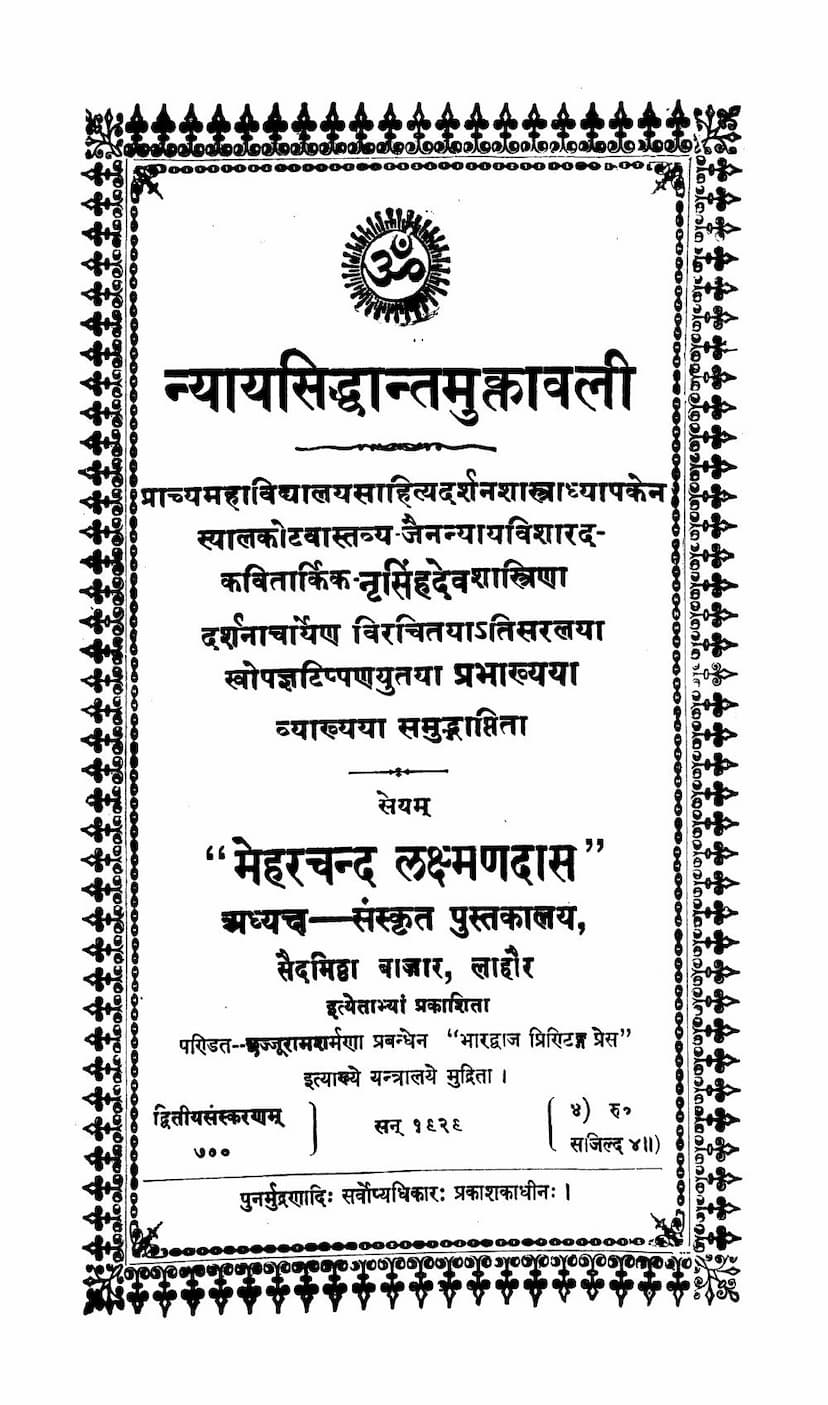Nyayasiddhant Muktavali
Added to library: September 2, 2025

Summary
The provided Jain text is the Nyayasiddhant Muktavali, authored by Maherchand Lakshmandas and published by Maherchand Lakshmandas. The catalog link is provided as https://jainqq.org/explore/002363/1. The text is a commentary on Jain Nyaya (logic and epistemology) and is dedicated to Principal A.C. Woolner of the University of Punjab for his work in promoting Sanskrit studies.
The included pages (1-20) cover the introductory sections and the beginning of the text. Here's a summary based on the content:
Book Title: Nyayasiddhant Muktavali (न्यायसिद्धान्तमुक्तावली) Author: Maherchand Lakshmandas (as publisher), but the commentary is by Nrisinhadeva Shastrin (नृसिंहदेवशास्त्रिणा). Publisher: Maherchand Lakshmandas Commentary Title: Prabha (प्रभा) by Nrisinhadeva Shastrin
Core Content and Themes Covered in the Provided Pages:
-
Introduction to Nyaya (Justice/Logic):
- The text begins by defining "Nyaya" (न्याय) as the examination of reality through proofs (pramanas).
- "Darshana" (दर्शन) is defined as that through which reality is seen. "Nyaya Darshana" is the philosophy of Nyaya, also referred to as "Nyaya Shastra" (न्यायशास्त्र).
- Nyaya is considered paramount, being the support for all sciences and the means for all actions. It is also called "Anvīkṣikī Vidyā" (आन्वीक्षिकी विद्या), the science of discernment or logic.
- It emphasizes its role in protecting Vedic truths by providing arguments that align with Vedic texts and refuting conflicting views.
-
The Purpose and Importance of Nyaya Shastra:
- The text strongly advocates for the utility of Nyaya Shastra, especially in the context of defending Vedic principles.
- It highlights Nyaya's power in refuting the logic of materialists like the Charvakas (चार्वाक) who deny God and the afterlife. Nyaya is presented as a sharp weapon to dismantle their arguments.
- The importance of logic (tarka) is emphasized, especially in understanding the Vedas and refuting atheistic views.
-
Arguments for the Existence of God (Ishvara):
- A significant portion of the introductory text (pages 6-13) is dedicated to discussing arguments for God's existence, particularly as a refutation of Charvaka philosophy.
- Arguments presented:
- Causality (Karyatvahetu): The universe, with its intricate design and effects (like the earth, trees, etc. - क्षित्यङ्कुरादिकं), must have a cause, just as a pot has a potter. This cause is identified as God.
- Intelligent Design: The order and purposefulness in the universe point to an intelligent creator.
- Counter-arguments and Refutations: The text anticipates and refutes objections, such as the claim that the universe is accidental or that material elements combining can produce consciousness.
- The "Body" of God: Arguments regarding whether God has a body are discussed, with the text suggesting that God's omnipotence and omniscience are essential attributes.
-
Debate on Causality and the Nature of the World:
- The text delves into the specifics of the "Karyatvahetu" (cause-effect) argument, analyzing what constitutes a "cause" (karta) and the "effect" (karya).
- It discusses the concept of "savayavatva" (having parts) in relation to God as the cause, refuting various interpretations of "savayavatva."
- The role of "upadhi" (qualification or condition) in arguments is also touched upon.
-
The Role of Inference (Anumana) in Theism:
- The text argues that even if God is not directly perceived (anupapanna), inference can establish God's existence, drawing parallels with inferring the existence of the soul from consciousness or wind from its effects.
-
Critique of Materialism and Nihilism:
- The Charvakas are described as denying a creator, attributing the world's origin to accidental combination of elements, and equating the soul with the physical body. Their views are strongly refuted.
-
Historical Context of Nyaya:
- The text briefly touches upon the lineage of Nyaya thinkers, mentioning Gautama Muni (गोतममुनि) as the author of the Nyaya Sutras (न्यायसूत्र).
- It mentions Vatsyayana Muni (वात्स्यायन) as the commentator on the Sutras, Uddyotakara (उद्योतकर) as the Vartikakara, and Shankaracharya (शङ्करभगवत्पाद) and Udayanacharya (उदयनाचार्य) in the philosophical timeline.
-
The Title "Nyayasiddhant Muktavali":
- The name itself suggests a string of pearls (Muktavali) of Nyaya principles or conclusions (Siddhanta). The commentary "Prabha" implies illumination or radiance.
-
Structure and Dedication:
- The book is structured into various "khandas" or sections, starting with "Pratyaksha Khanda" (प्रत्यक्षखण्डम् - Perception section) as per the table of contents (Page 22).
- The dedication highlights the importance of Sanskrit education.
In summary, the initial pages of the Nyayasiddhant Muktavali, as presented, serve as a robust introduction to the philosophy of Nyaya, emphasizing its logical rigor, its necessity for understanding Vedic truths, and its crucial role in establishing the existence of God by refuting atheistic and materialistic viewpoints. The commentary by Nrisinhadeva Shastrin aims to make these complex philosophical arguments accessible.